Leadership in Business: Strategic Leadership Analysis of Camilla Kato
VerifiedAdded on 2023/01/17
|11
|2585
|76
Report
AI Summary
This report analyzes the leadership of Camilla Kato at Boxgrove Hospital, focusing on her strategic approach to address issues of reduced trust and financial crisis. The report examines her implementation of flexible leadership theory, emphasizing human resources and relationships. It details key changes, including cost reduction through cross-functional teams, the installation of a flatter organizational structure, leadership development programs, and a zero-tolerance bullying initiative. The report also discusses the impact of Camilla's skills, abilities, and leadership style, including her adoption of transformational and democratic leadership, on her ability to drive organizational change and improve performance. The analysis considers issues of gender and leadership, and the report concludes by highlighting the effectiveness of her leadership in transforming the hospital's environment and outcomes.
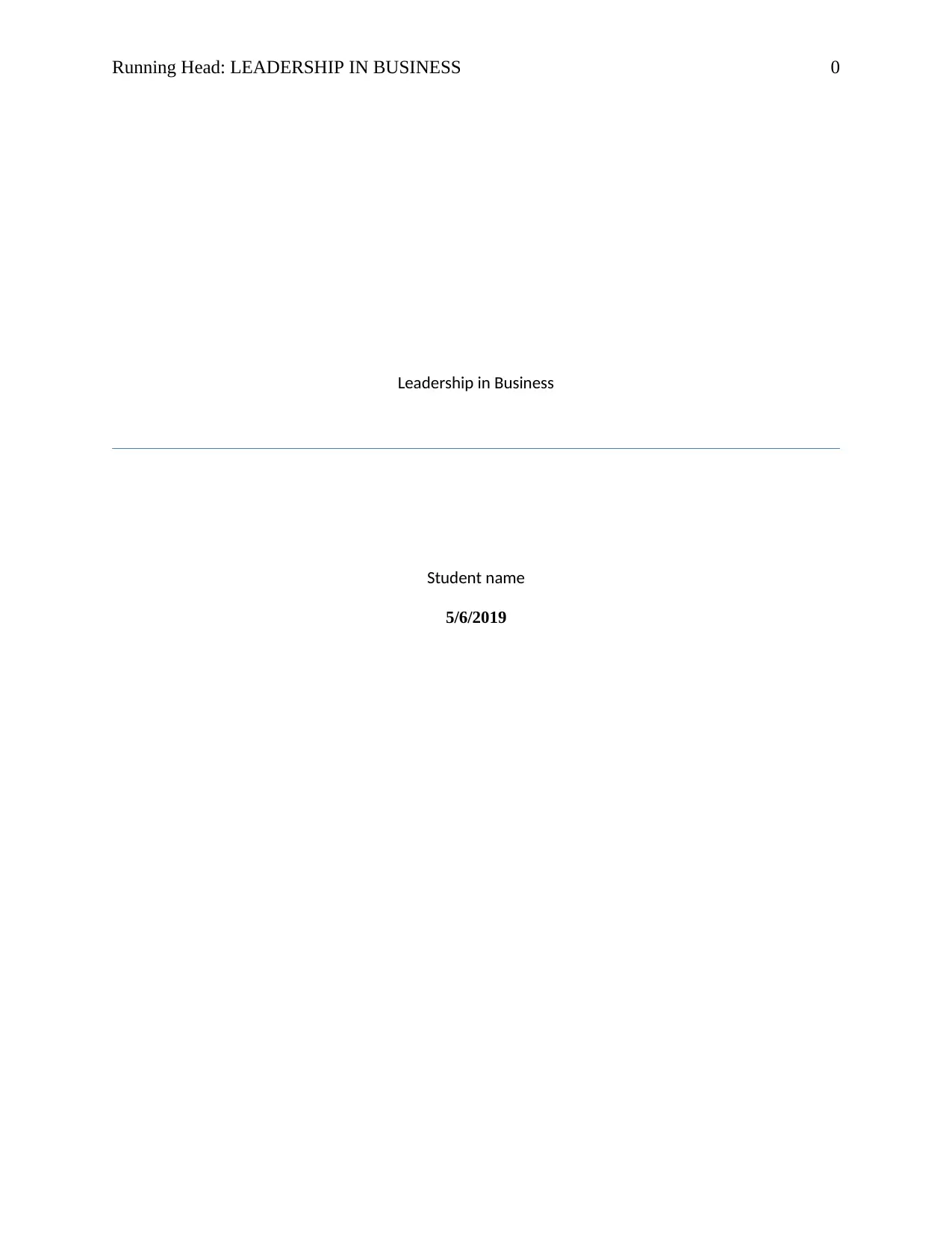
Running Head: LEADERSHIP IN BUSINESS 0
Leadership in Business
Student name
5/6/2019
Leadership in Business
Student name
5/6/2019
Paraphrase This Document
Need a fresh take? Get an instant paraphrase of this document with our AI Paraphraser
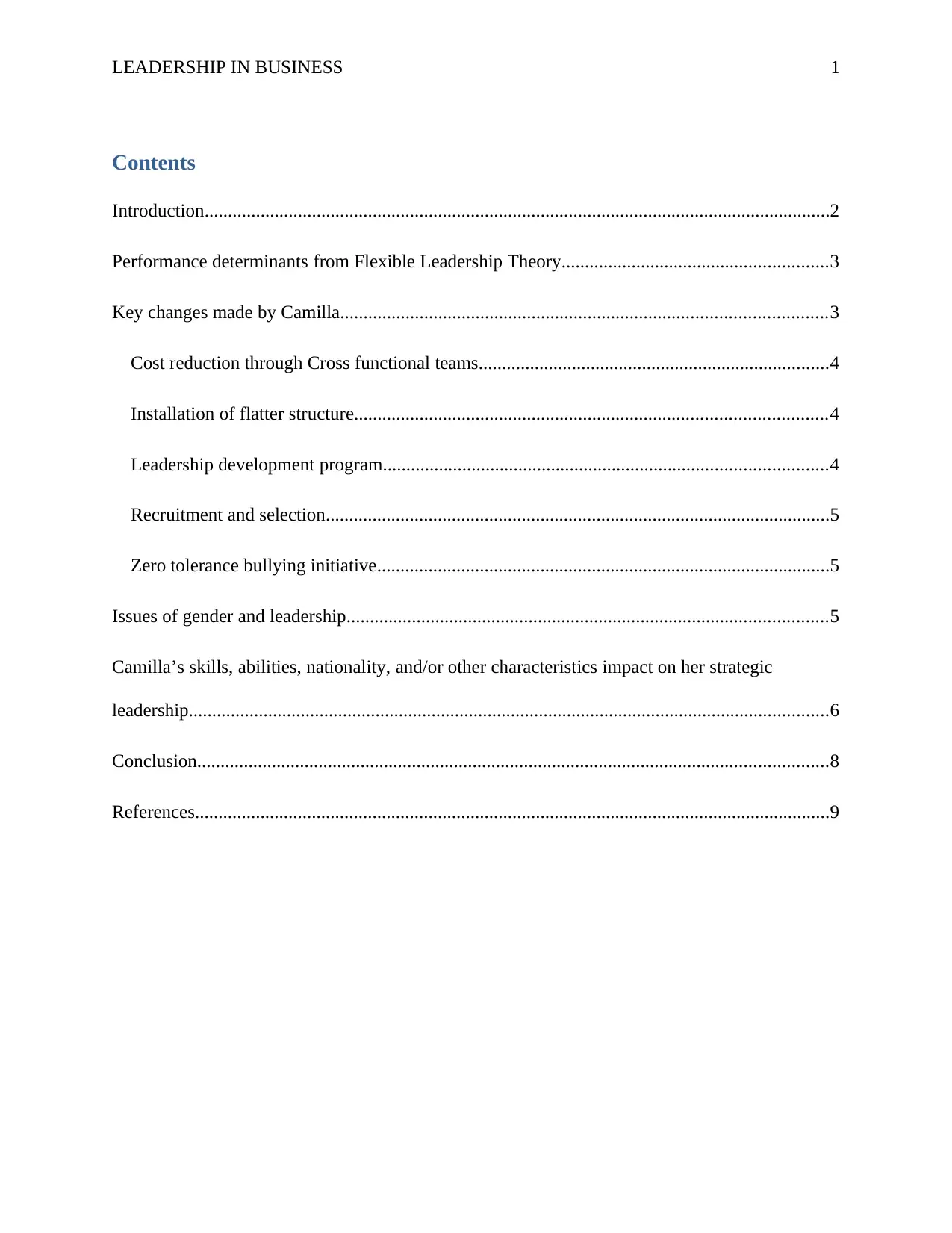
LEADERSHIP IN BUSINESS 1
Contents
Introduction......................................................................................................................................2
Performance determinants from Flexible Leadership Theory.........................................................3
Key changes made by Camilla........................................................................................................3
Cost reduction through Cross functional teams...........................................................................4
Installation of flatter structure.....................................................................................................4
Leadership development program...............................................................................................4
Recruitment and selection............................................................................................................5
Zero tolerance bullying initiative.................................................................................................5
Issues of gender and leadership.......................................................................................................5
Camilla’s skills, abilities, nationality, and/or other characteristics impact on her strategic
leadership.........................................................................................................................................6
Conclusion.......................................................................................................................................8
References........................................................................................................................................9
Contents
Introduction......................................................................................................................................2
Performance determinants from Flexible Leadership Theory.........................................................3
Key changes made by Camilla........................................................................................................3
Cost reduction through Cross functional teams...........................................................................4
Installation of flatter structure.....................................................................................................4
Leadership development program...............................................................................................4
Recruitment and selection............................................................................................................5
Zero tolerance bullying initiative.................................................................................................5
Issues of gender and leadership.......................................................................................................5
Camilla’s skills, abilities, nationality, and/or other characteristics impact on her strategic
leadership.........................................................................................................................................6
Conclusion.......................................................................................................................................8
References........................................................................................................................................9
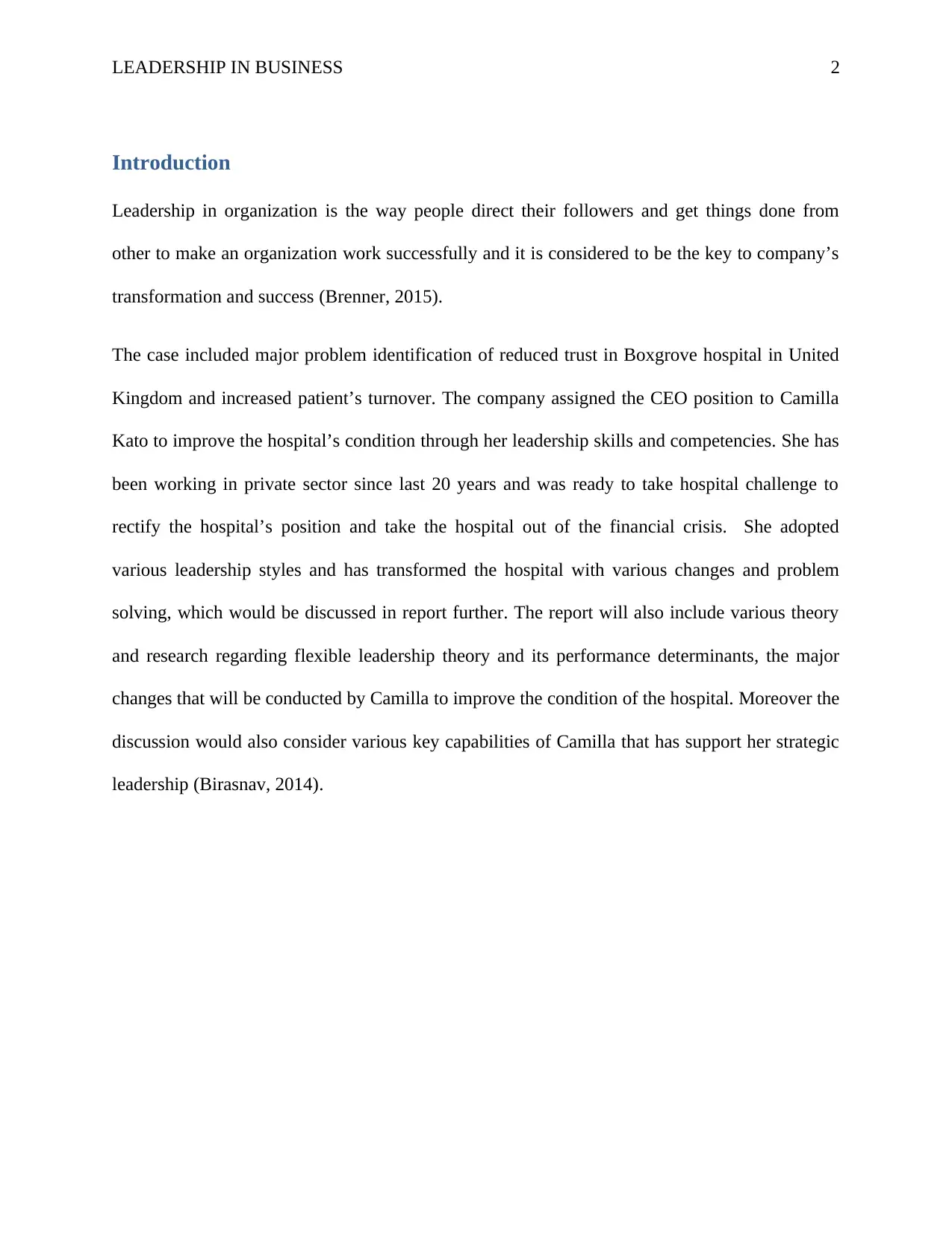
LEADERSHIP IN BUSINESS 2
Introduction
Leadership in organization is the way people direct their followers and get things done from
other to make an organization work successfully and it is considered to be the key to company’s
transformation and success (Brenner, 2015).
The case included major problem identification of reduced trust in Boxgrove hospital in United
Kingdom and increased patient’s turnover. The company assigned the CEO position to Camilla
Kato to improve the hospital’s condition through her leadership skills and competencies. She has
been working in private sector since last 20 years and was ready to take hospital challenge to
rectify the hospital’s position and take the hospital out of the financial crisis. She adopted
various leadership styles and has transformed the hospital with various changes and problem
solving, which would be discussed in report further. The report will also include various theory
and research regarding flexible leadership theory and its performance determinants, the major
changes that will be conducted by Camilla to improve the condition of the hospital. Moreover the
discussion would also consider various key capabilities of Camilla that has support her strategic
leadership (Birasnav, 2014).
Introduction
Leadership in organization is the way people direct their followers and get things done from
other to make an organization work successfully and it is considered to be the key to company’s
transformation and success (Brenner, 2015).
The case included major problem identification of reduced trust in Boxgrove hospital in United
Kingdom and increased patient’s turnover. The company assigned the CEO position to Camilla
Kato to improve the hospital’s condition through her leadership skills and competencies. She has
been working in private sector since last 20 years and was ready to take hospital challenge to
rectify the hospital’s position and take the hospital out of the financial crisis. She adopted
various leadership styles and has transformed the hospital with various changes and problem
solving, which would be discussed in report further. The report will also include various theory
and research regarding flexible leadership theory and its performance determinants, the major
changes that will be conducted by Camilla to improve the condition of the hospital. Moreover the
discussion would also consider various key capabilities of Camilla that has support her strategic
leadership (Birasnav, 2014).
⊘ This is a preview!⊘
Do you want full access?
Subscribe today to unlock all pages.

Trusted by 1+ million students worldwide
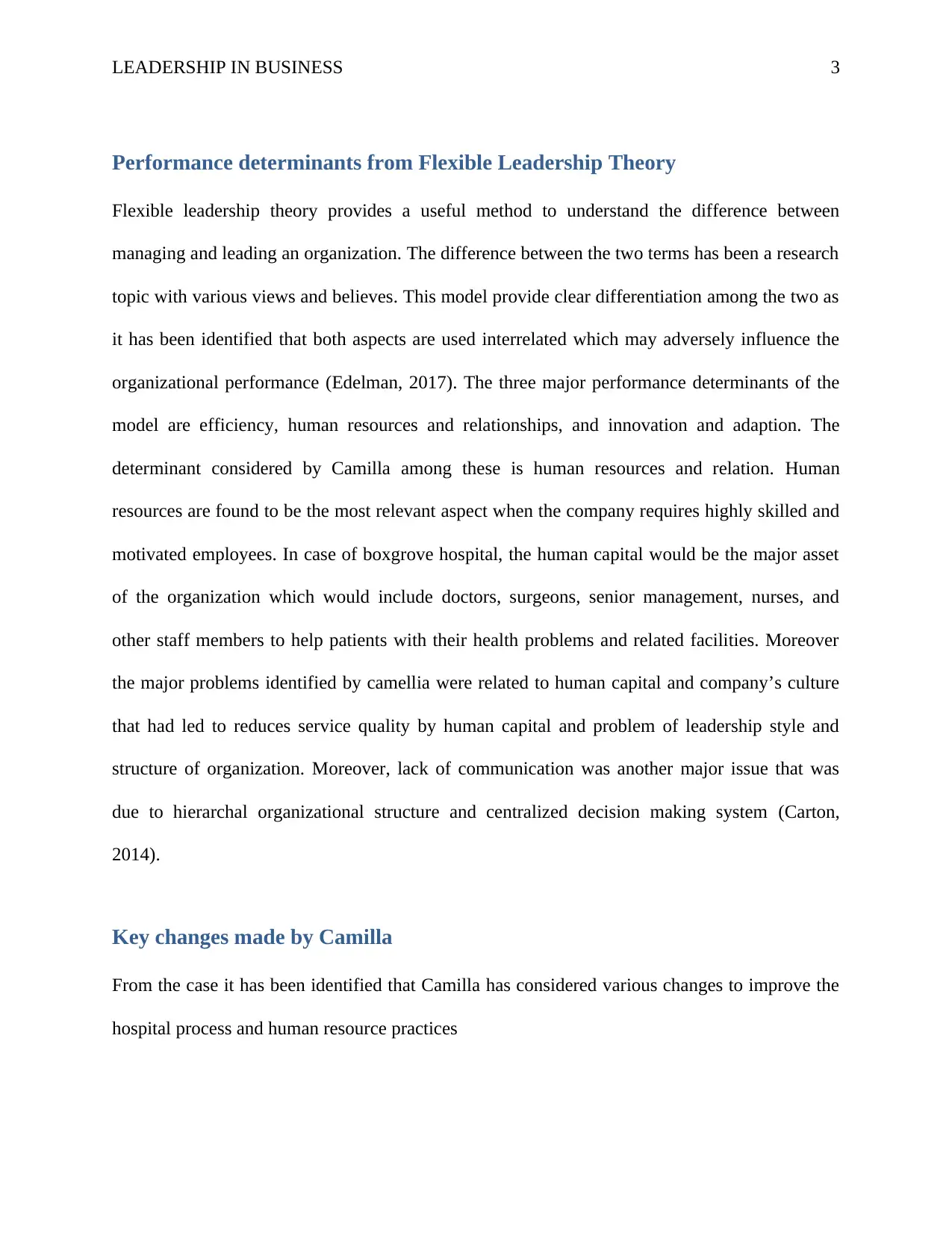
LEADERSHIP IN BUSINESS 3
Performance determinants from Flexible Leadership Theory
Flexible leadership theory provides a useful method to understand the difference between
managing and leading an organization. The difference between the two terms has been a research
topic with various views and believes. This model provide clear differentiation among the two as
it has been identified that both aspects are used interrelated which may adversely influence the
organizational performance (Edelman, 2017). The three major performance determinants of the
model are efficiency, human resources and relationships, and innovation and adaption. The
determinant considered by Camilla among these is human resources and relation. Human
resources are found to be the most relevant aspect when the company requires highly skilled and
motivated employees. In case of boxgrove hospital, the human capital would be the major asset
of the organization which would include doctors, surgeons, senior management, nurses, and
other staff members to help patients with their health problems and related facilities. Moreover
the major problems identified by camellia were related to human capital and company’s culture
that had led to reduces service quality by human capital and problem of leadership style and
structure of organization. Moreover, lack of communication was another major issue that was
due to hierarchal organizational structure and centralized decision making system (Carton,
2014).
Key changes made by Camilla
From the case it has been identified that Camilla has considered various changes to improve the
hospital process and human resource practices
Performance determinants from Flexible Leadership Theory
Flexible leadership theory provides a useful method to understand the difference between
managing and leading an organization. The difference between the two terms has been a research
topic with various views and believes. This model provide clear differentiation among the two as
it has been identified that both aspects are used interrelated which may adversely influence the
organizational performance (Edelman, 2017). The three major performance determinants of the
model are efficiency, human resources and relationships, and innovation and adaption. The
determinant considered by Camilla among these is human resources and relation. Human
resources are found to be the most relevant aspect when the company requires highly skilled and
motivated employees. In case of boxgrove hospital, the human capital would be the major asset
of the organization which would include doctors, surgeons, senior management, nurses, and
other staff members to help patients with their health problems and related facilities. Moreover
the major problems identified by camellia were related to human capital and company’s culture
that had led to reduces service quality by human capital and problem of leadership style and
structure of organization. Moreover, lack of communication was another major issue that was
due to hierarchal organizational structure and centralized decision making system (Carton,
2014).
Key changes made by Camilla
From the case it has been identified that Camilla has considered various changes to improve the
hospital process and human resource practices
Paraphrase This Document
Need a fresh take? Get an instant paraphrase of this document with our AI Paraphraser
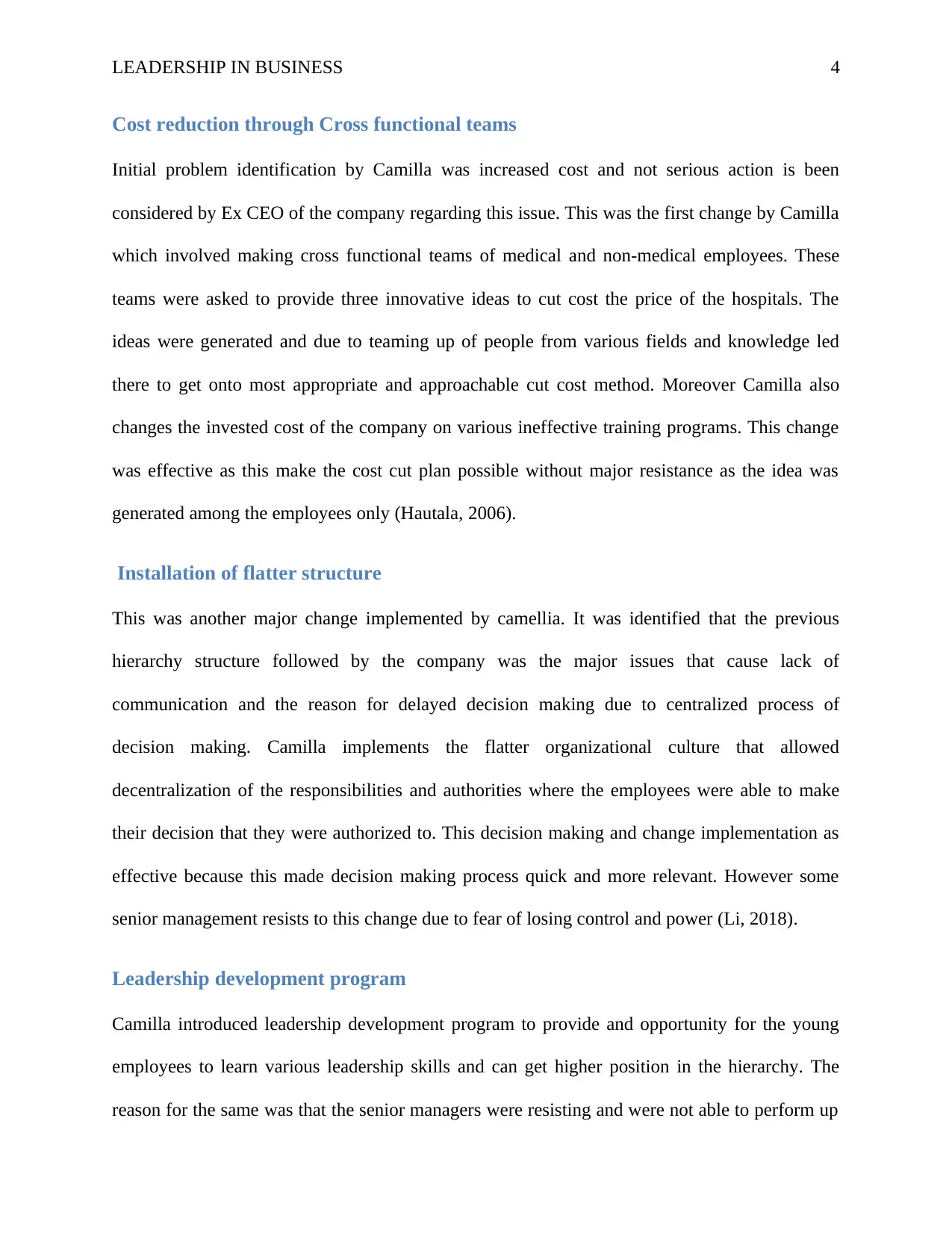
LEADERSHIP IN BUSINESS 4
Cost reduction through Cross functional teams
Initial problem identification by Camilla was increased cost and not serious action is been
considered by Ex CEO of the company regarding this issue. This was the first change by Camilla
which involved making cross functional teams of medical and non-medical employees. These
teams were asked to provide three innovative ideas to cut cost the price of the hospitals. The
ideas were generated and due to teaming up of people from various fields and knowledge led
there to get onto most appropriate and approachable cut cost method. Moreover Camilla also
changes the invested cost of the company on various ineffective training programs. This change
was effective as this make the cost cut plan possible without major resistance as the idea was
generated among the employees only (Hautala, 2006).
Installation of flatter structure
This was another major change implemented by camellia. It was identified that the previous
hierarchy structure followed by the company was the major issues that cause lack of
communication and the reason for delayed decision making due to centralized process of
decision making. Camilla implements the flatter organizational culture that allowed
decentralization of the responsibilities and authorities where the employees were able to make
their decision that they were authorized to. This decision making and change implementation as
effective because this made decision making process quick and more relevant. However some
senior management resists to this change due to fear of losing control and power (Li, 2018).
Leadership development program
Camilla introduced leadership development program to provide and opportunity for the young
employees to learn various leadership skills and can get higher position in the hierarchy. The
reason for the same was that the senior managers were resisting and were not able to perform up
Cost reduction through Cross functional teams
Initial problem identification by Camilla was increased cost and not serious action is been
considered by Ex CEO of the company regarding this issue. This was the first change by Camilla
which involved making cross functional teams of medical and non-medical employees. These
teams were asked to provide three innovative ideas to cut cost the price of the hospitals. The
ideas were generated and due to teaming up of people from various fields and knowledge led
there to get onto most appropriate and approachable cut cost method. Moreover Camilla also
changes the invested cost of the company on various ineffective training programs. This change
was effective as this make the cost cut plan possible without major resistance as the idea was
generated among the employees only (Hautala, 2006).
Installation of flatter structure
This was another major change implemented by camellia. It was identified that the previous
hierarchy structure followed by the company was the major issues that cause lack of
communication and the reason for delayed decision making due to centralized process of
decision making. Camilla implements the flatter organizational culture that allowed
decentralization of the responsibilities and authorities where the employees were able to make
their decision that they were authorized to. This decision making and change implementation as
effective because this made decision making process quick and more relevant. However some
senior management resists to this change due to fear of losing control and power (Li, 2018).
Leadership development program
Camilla introduced leadership development program to provide and opportunity for the young
employees to learn various leadership skills and can get higher position in the hierarchy. The
reason for the same was that the senior managers were resisting and were not able to perform up
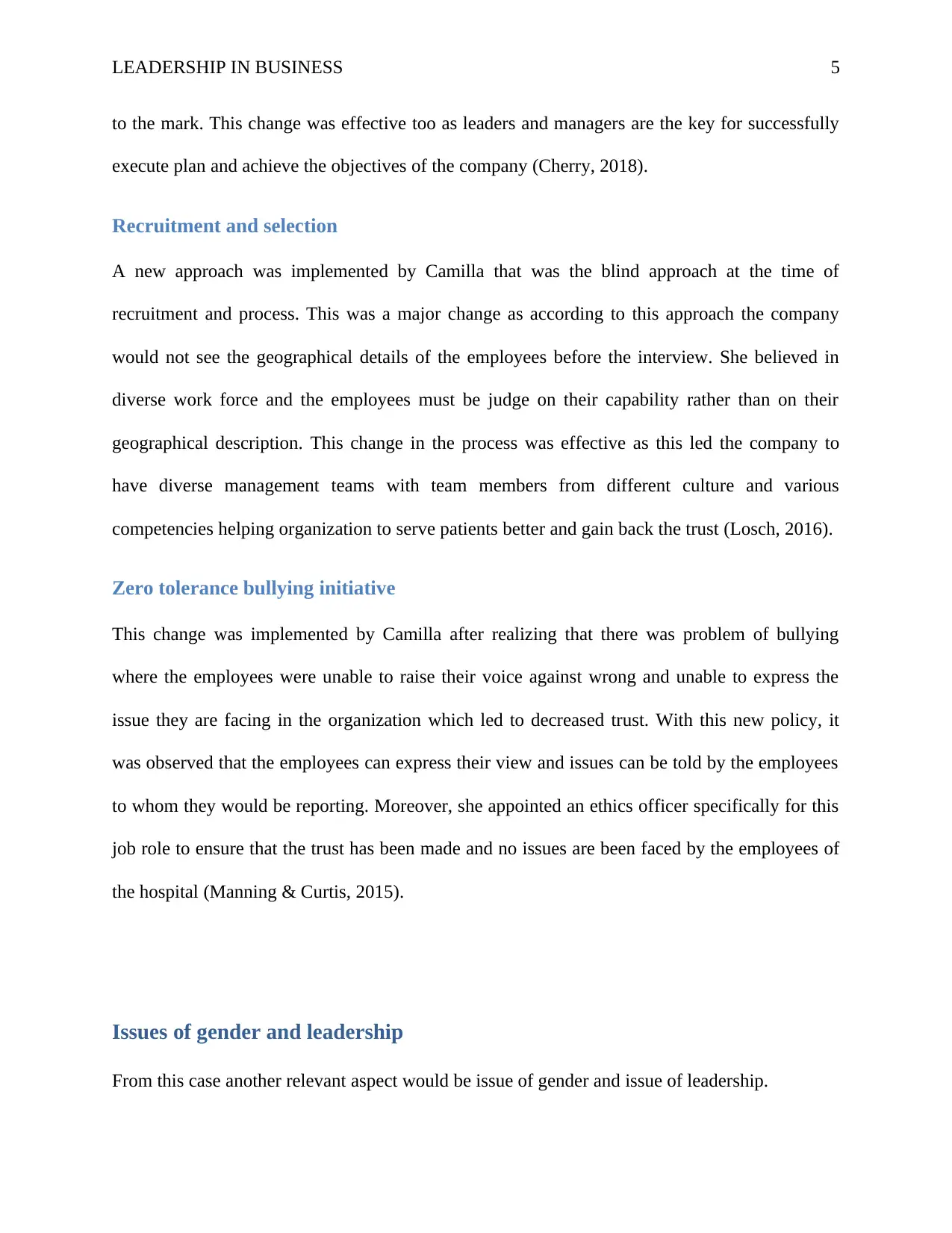
LEADERSHIP IN BUSINESS 5
to the mark. This change was effective too as leaders and managers are the key for successfully
execute plan and achieve the objectives of the company (Cherry, 2018).
Recruitment and selection
A new approach was implemented by Camilla that was the blind approach at the time of
recruitment and process. This was a major change as according to this approach the company
would not see the geographical details of the employees before the interview. She believed in
diverse work force and the employees must be judge on their capability rather than on their
geographical description. This change in the process was effective as this led the company to
have diverse management teams with team members from different culture and various
competencies helping organization to serve patients better and gain back the trust (Losch, 2016).
Zero tolerance bullying initiative
This change was implemented by Camilla after realizing that there was problem of bullying
where the employees were unable to raise their voice against wrong and unable to express the
issue they are facing in the organization which led to decreased trust. With this new policy, it
was observed that the employees can express their view and issues can be told by the employees
to whom they would be reporting. Moreover, she appointed an ethics officer specifically for this
job role to ensure that the trust has been made and no issues are been faced by the employees of
the hospital (Manning & Curtis, 2015).
Issues of gender and leadership
From this case another relevant aspect would be issue of gender and issue of leadership.
to the mark. This change was effective too as leaders and managers are the key for successfully
execute plan and achieve the objectives of the company (Cherry, 2018).
Recruitment and selection
A new approach was implemented by Camilla that was the blind approach at the time of
recruitment and process. This was a major change as according to this approach the company
would not see the geographical details of the employees before the interview. She believed in
diverse work force and the employees must be judge on their capability rather than on their
geographical description. This change in the process was effective as this led the company to
have diverse management teams with team members from different culture and various
competencies helping organization to serve patients better and gain back the trust (Losch, 2016).
Zero tolerance bullying initiative
This change was implemented by Camilla after realizing that there was problem of bullying
where the employees were unable to raise their voice against wrong and unable to express the
issue they are facing in the organization which led to decreased trust. With this new policy, it
was observed that the employees can express their view and issues can be told by the employees
to whom they would be reporting. Moreover, she appointed an ethics officer specifically for this
job role to ensure that the trust has been made and no issues are been faced by the employees of
the hospital (Manning & Curtis, 2015).
Issues of gender and leadership
From this case another relevant aspect would be issue of gender and issue of leadership.
⊘ This is a preview!⊘
Do you want full access?
Subscribe today to unlock all pages.

Trusted by 1+ million students worldwide
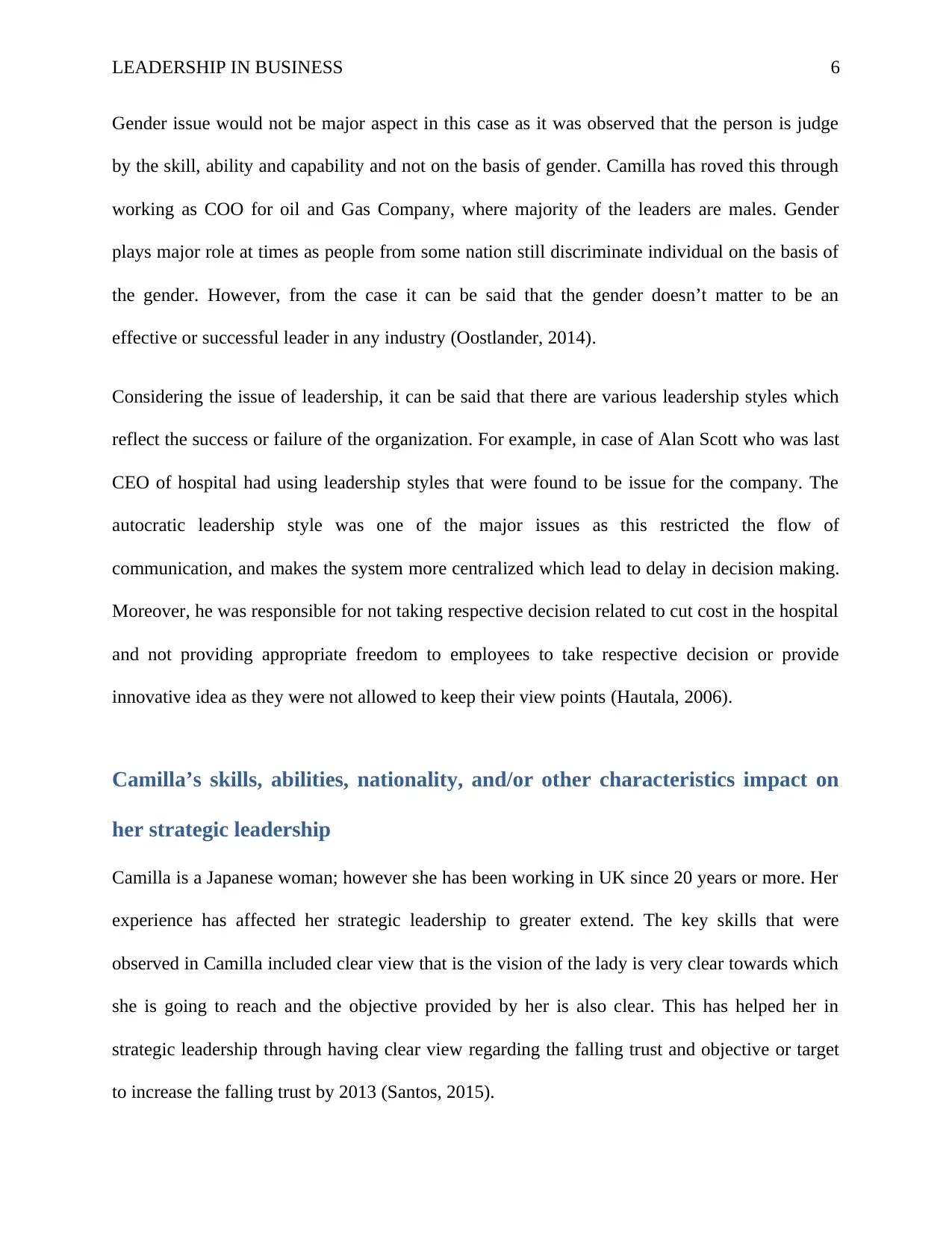
LEADERSHIP IN BUSINESS 6
Gender issue would not be major aspect in this case as it was observed that the person is judge
by the skill, ability and capability and not on the basis of gender. Camilla has roved this through
working as COO for oil and Gas Company, where majority of the leaders are males. Gender
plays major role at times as people from some nation still discriminate individual on the basis of
the gender. However, from the case it can be said that the gender doesn’t matter to be an
effective or successful leader in any industry (Oostlander, 2014).
Considering the issue of leadership, it can be said that there are various leadership styles which
reflect the success or failure of the organization. For example, in case of Alan Scott who was last
CEO of hospital had using leadership styles that were found to be issue for the company. The
autocratic leadership style was one of the major issues as this restricted the flow of
communication, and makes the system more centralized which lead to delay in decision making.
Moreover, he was responsible for not taking respective decision related to cut cost in the hospital
and not providing appropriate freedom to employees to take respective decision or provide
innovative idea as they were not allowed to keep their view points (Hautala, 2006).
Camilla’s skills, abilities, nationality, and/or other characteristics impact on
her strategic leadership
Camilla is a Japanese woman; however she has been working in UK since 20 years or more. Her
experience has affected her strategic leadership to greater extend. The key skills that were
observed in Camilla included clear view that is the vision of the lady is very clear towards which
she is going to reach and the objective provided by her is also clear. This has helped her in
strategic leadership through having clear view regarding the falling trust and objective or target
to increase the falling trust by 2013 (Santos, 2015).
Gender issue would not be major aspect in this case as it was observed that the person is judge
by the skill, ability and capability and not on the basis of gender. Camilla has roved this through
working as COO for oil and Gas Company, where majority of the leaders are males. Gender
plays major role at times as people from some nation still discriminate individual on the basis of
the gender. However, from the case it can be said that the gender doesn’t matter to be an
effective or successful leader in any industry (Oostlander, 2014).
Considering the issue of leadership, it can be said that there are various leadership styles which
reflect the success or failure of the organization. For example, in case of Alan Scott who was last
CEO of hospital had using leadership styles that were found to be issue for the company. The
autocratic leadership style was one of the major issues as this restricted the flow of
communication, and makes the system more centralized which lead to delay in decision making.
Moreover, he was responsible for not taking respective decision related to cut cost in the hospital
and not providing appropriate freedom to employees to take respective decision or provide
innovative idea as they were not allowed to keep their view points (Hautala, 2006).
Camilla’s skills, abilities, nationality, and/or other characteristics impact on
her strategic leadership
Camilla is a Japanese woman; however she has been working in UK since 20 years or more. Her
experience has affected her strategic leadership to greater extend. The key skills that were
observed in Camilla included clear view that is the vision of the lady is very clear towards which
she is going to reach and the objective provided by her is also clear. This has helped her in
strategic leadership through having clear view regarding the falling trust and objective or target
to increase the falling trust by 2013 (Santos, 2015).
Paraphrase This Document
Need a fresh take? Get an instant paraphrase of this document with our AI Paraphraser
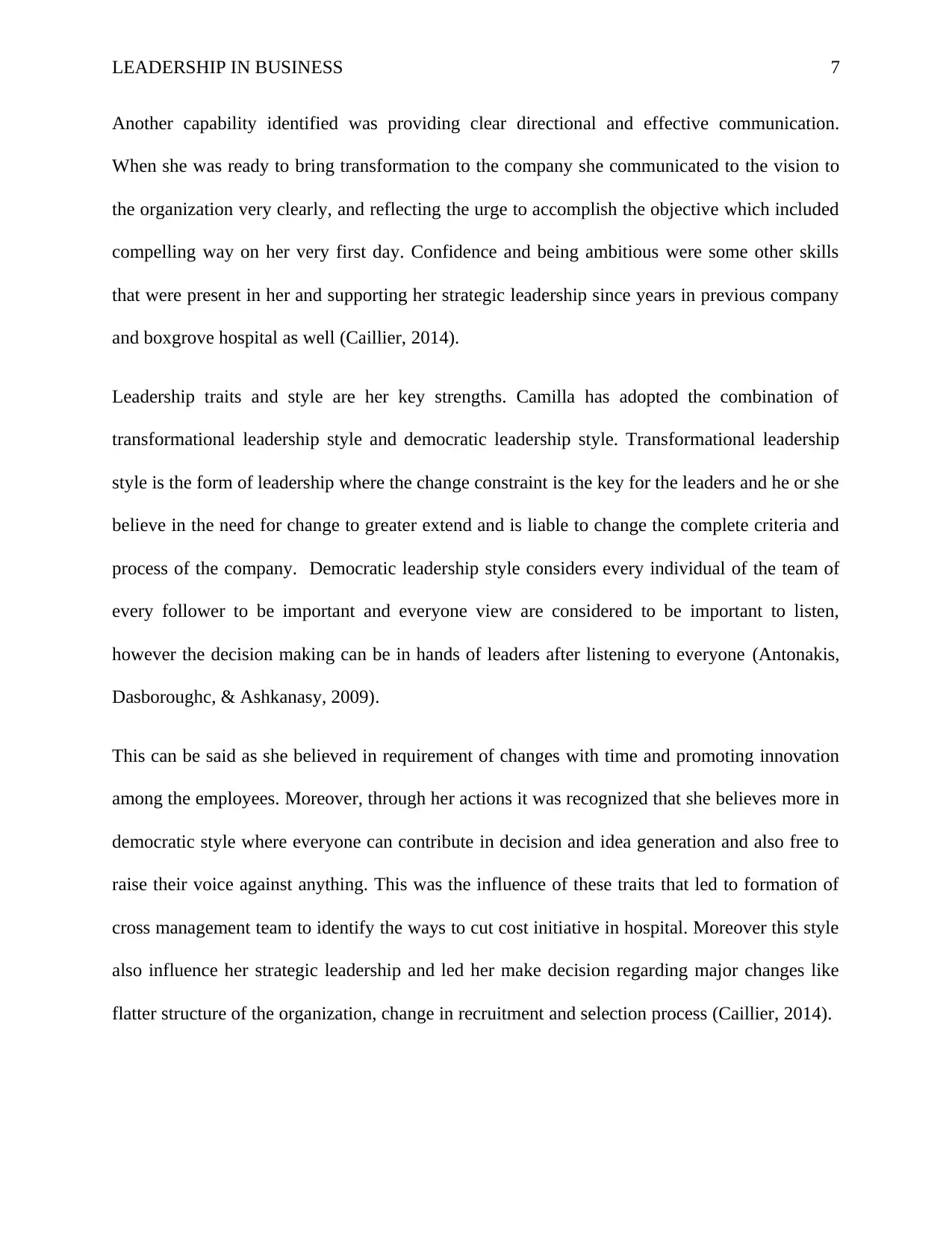
LEADERSHIP IN BUSINESS 7
Another capability identified was providing clear directional and effective communication.
When she was ready to bring transformation to the company she communicated to the vision to
the organization very clearly, and reflecting the urge to accomplish the objective which included
compelling way on her very first day. Confidence and being ambitious were some other skills
that were present in her and supporting her strategic leadership since years in previous company
and boxgrove hospital as well (Caillier, 2014).
Leadership traits and style are her key strengths. Camilla has adopted the combination of
transformational leadership style and democratic leadership style. Transformational leadership
style is the form of leadership where the change constraint is the key for the leaders and he or she
believe in the need for change to greater extend and is liable to change the complete criteria and
process of the company. Democratic leadership style considers every individual of the team of
every follower to be important and everyone view are considered to be important to listen,
however the decision making can be in hands of leaders after listening to everyone (Antonakis,
Dasboroughc, & Ashkanasy, 2009).
This can be said as she believed in requirement of changes with time and promoting innovation
among the employees. Moreover, through her actions it was recognized that she believes more in
democratic style where everyone can contribute in decision and idea generation and also free to
raise their voice against anything. This was the influence of these traits that led to formation of
cross management team to identify the ways to cut cost initiative in hospital. Moreover this style
also influence her strategic leadership and led her make decision regarding major changes like
flatter structure of the organization, change in recruitment and selection process (Caillier, 2014).
Another capability identified was providing clear directional and effective communication.
When she was ready to bring transformation to the company she communicated to the vision to
the organization very clearly, and reflecting the urge to accomplish the objective which included
compelling way on her very first day. Confidence and being ambitious were some other skills
that were present in her and supporting her strategic leadership since years in previous company
and boxgrove hospital as well (Caillier, 2014).
Leadership traits and style are her key strengths. Camilla has adopted the combination of
transformational leadership style and democratic leadership style. Transformational leadership
style is the form of leadership where the change constraint is the key for the leaders and he or she
believe in the need for change to greater extend and is liable to change the complete criteria and
process of the company. Democratic leadership style considers every individual of the team of
every follower to be important and everyone view are considered to be important to listen,
however the decision making can be in hands of leaders after listening to everyone (Antonakis,
Dasboroughc, & Ashkanasy, 2009).
This can be said as she believed in requirement of changes with time and promoting innovation
among the employees. Moreover, through her actions it was recognized that she believes more in
democratic style where everyone can contribute in decision and idea generation and also free to
raise their voice against anything. This was the influence of these traits that led to formation of
cross management team to identify the ways to cut cost initiative in hospital. Moreover this style
also influence her strategic leadership and led her make decision regarding major changes like
flatter structure of the organization, change in recruitment and selection process (Caillier, 2014).
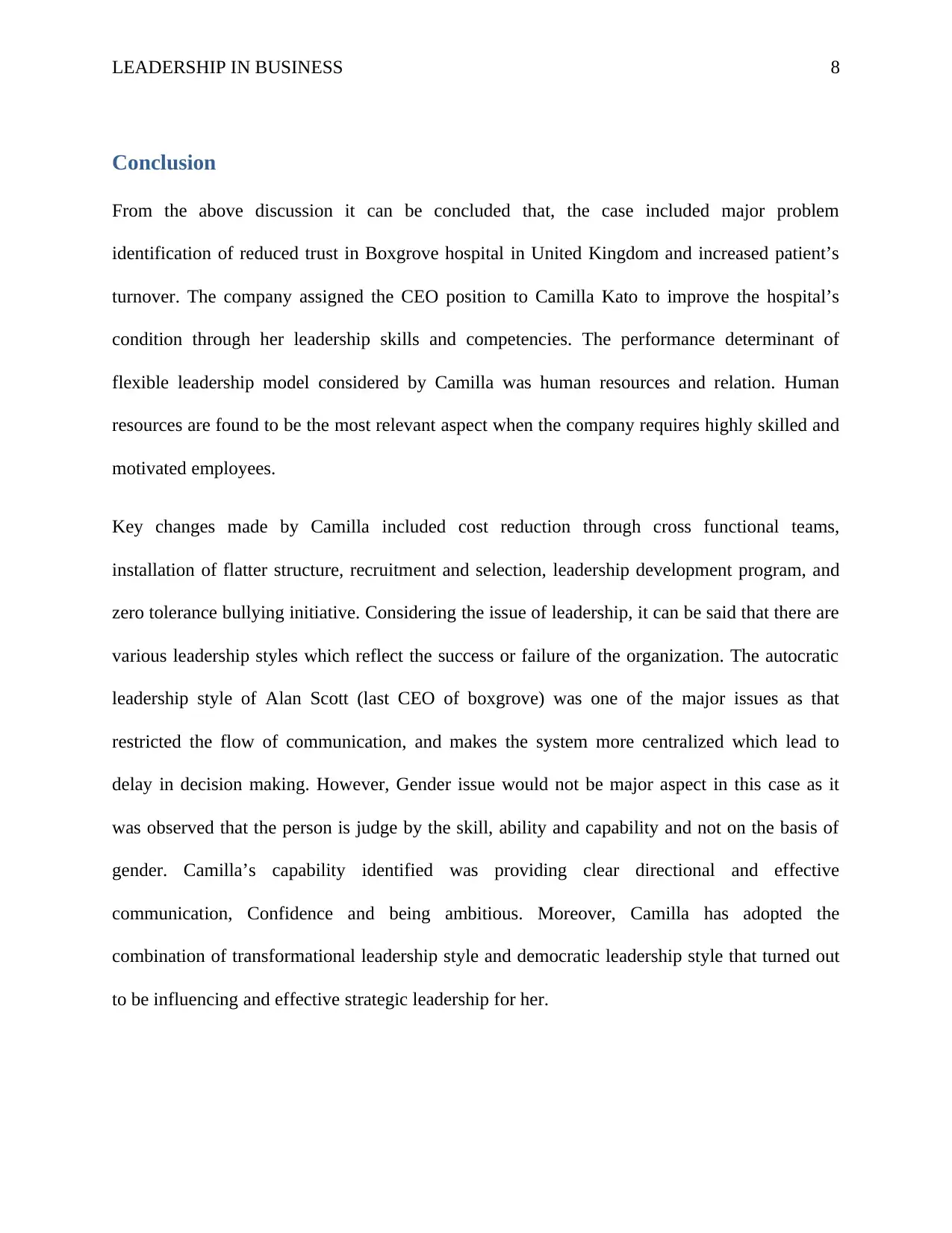
LEADERSHIP IN BUSINESS 8
Conclusion
From the above discussion it can be concluded that, the case included major problem
identification of reduced trust in Boxgrove hospital in United Kingdom and increased patient’s
turnover. The company assigned the CEO position to Camilla Kato to improve the hospital’s
condition through her leadership skills and competencies. The performance determinant of
flexible leadership model considered by Camilla was human resources and relation. Human
resources are found to be the most relevant aspect when the company requires highly skilled and
motivated employees.
Key changes made by Camilla included cost reduction through cross functional teams,
installation of flatter structure, recruitment and selection, leadership development program, and
zero tolerance bullying initiative. Considering the issue of leadership, it can be said that there are
various leadership styles which reflect the success or failure of the organization. The autocratic
leadership style of Alan Scott (last CEO of boxgrove) was one of the major issues as that
restricted the flow of communication, and makes the system more centralized which lead to
delay in decision making. However, Gender issue would not be major aspect in this case as it
was observed that the person is judge by the skill, ability and capability and not on the basis of
gender. Camilla’s capability identified was providing clear directional and effective
communication, Confidence and being ambitious. Moreover, Camilla has adopted the
combination of transformational leadership style and democratic leadership style that turned out
to be influencing and effective strategic leadership for her.
Conclusion
From the above discussion it can be concluded that, the case included major problem
identification of reduced trust in Boxgrove hospital in United Kingdom and increased patient’s
turnover. The company assigned the CEO position to Camilla Kato to improve the hospital’s
condition through her leadership skills and competencies. The performance determinant of
flexible leadership model considered by Camilla was human resources and relation. Human
resources are found to be the most relevant aspect when the company requires highly skilled and
motivated employees.
Key changes made by Camilla included cost reduction through cross functional teams,
installation of flatter structure, recruitment and selection, leadership development program, and
zero tolerance bullying initiative. Considering the issue of leadership, it can be said that there are
various leadership styles which reflect the success or failure of the organization. The autocratic
leadership style of Alan Scott (last CEO of boxgrove) was one of the major issues as that
restricted the flow of communication, and makes the system more centralized which lead to
delay in decision making. However, Gender issue would not be major aspect in this case as it
was observed that the person is judge by the skill, ability and capability and not on the basis of
gender. Camilla’s capability identified was providing clear directional and effective
communication, Confidence and being ambitious. Moreover, Camilla has adopted the
combination of transformational leadership style and democratic leadership style that turned out
to be influencing and effective strategic leadership for her.
⊘ This is a preview!⊘
Do you want full access?
Subscribe today to unlock all pages.

Trusted by 1+ million students worldwide
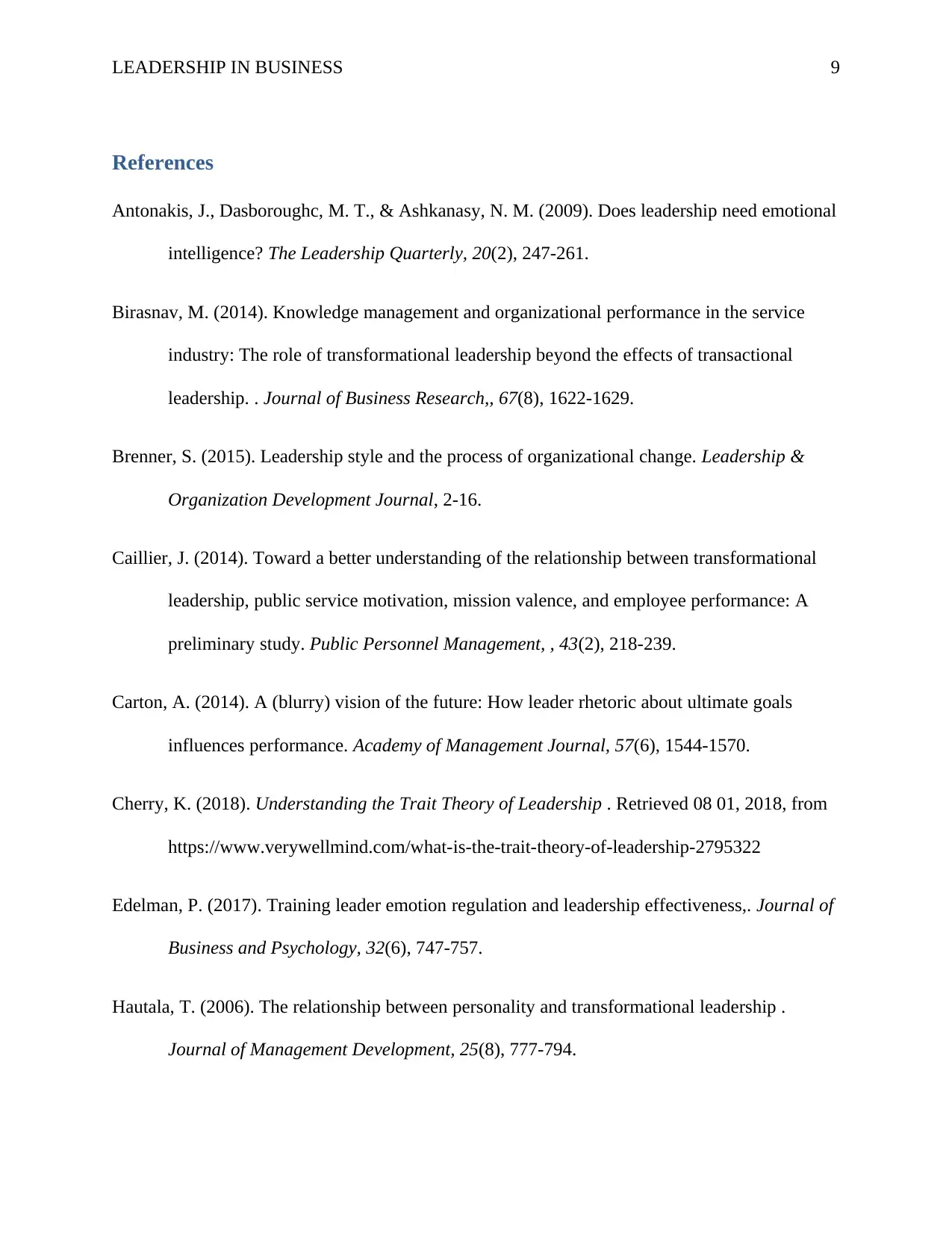
LEADERSHIP IN BUSINESS 9
References
Antonakis, J., Dasboroughc, M. T., & Ashkanasy, N. M. (2009). Does leadership need emotional
intelligence? The Leadership Quarterly, 20(2), 247-261.
Birasnav, M. (2014). Knowledge management and organizational performance in the service
industry: The role of transformational leadership beyond the effects of transactional
leadership. . Journal of Business Research,, 67(8), 1622-1629.
Brenner, S. (2015). Leadership style and the process of organizational change. Leadership &
Organization Development Journal, 2-16.
Caillier, J. (2014). Toward a better understanding of the relationship between transformational
leadership, public service motivation, mission valence, and employee performance: A
preliminary study. Public Personnel Management, , 43(2), 218-239.
Carton, A. (2014). A (blurry) vision of the future: How leader rhetoric about ultimate goals
influences performance. Academy of Management Journal, 57(6), 1544-1570.
Cherry, K. (2018). Understanding the Trait Theory of Leadership . Retrieved 08 01, 2018, from
https://www.verywellmind.com/what-is-the-trait-theory-of-leadership-2795322
Edelman, P. (2017). Training leader emotion regulation and leadership effectiveness,. Journal of
Business and Psychology, 32(6), 747-757.
Hautala, T. (2006). The relationship between personality and transformational leadership .
Journal of Management Development, 25(8), 777-794.
References
Antonakis, J., Dasboroughc, M. T., & Ashkanasy, N. M. (2009). Does leadership need emotional
intelligence? The Leadership Quarterly, 20(2), 247-261.
Birasnav, M. (2014). Knowledge management and organizational performance in the service
industry: The role of transformational leadership beyond the effects of transactional
leadership. . Journal of Business Research,, 67(8), 1622-1629.
Brenner, S. (2015). Leadership style and the process of organizational change. Leadership &
Organization Development Journal, 2-16.
Caillier, J. (2014). Toward a better understanding of the relationship between transformational
leadership, public service motivation, mission valence, and employee performance: A
preliminary study. Public Personnel Management, , 43(2), 218-239.
Carton, A. (2014). A (blurry) vision of the future: How leader rhetoric about ultimate goals
influences performance. Academy of Management Journal, 57(6), 1544-1570.
Cherry, K. (2018). Understanding the Trait Theory of Leadership . Retrieved 08 01, 2018, from
https://www.verywellmind.com/what-is-the-trait-theory-of-leadership-2795322
Edelman, P. (2017). Training leader emotion regulation and leadership effectiveness,. Journal of
Business and Psychology, 32(6), 747-757.
Hautala, T. (2006). The relationship between personality and transformational leadership .
Journal of Management Development, 25(8), 777-794.
Paraphrase This Document
Need a fresh take? Get an instant paraphrase of this document with our AI Paraphraser
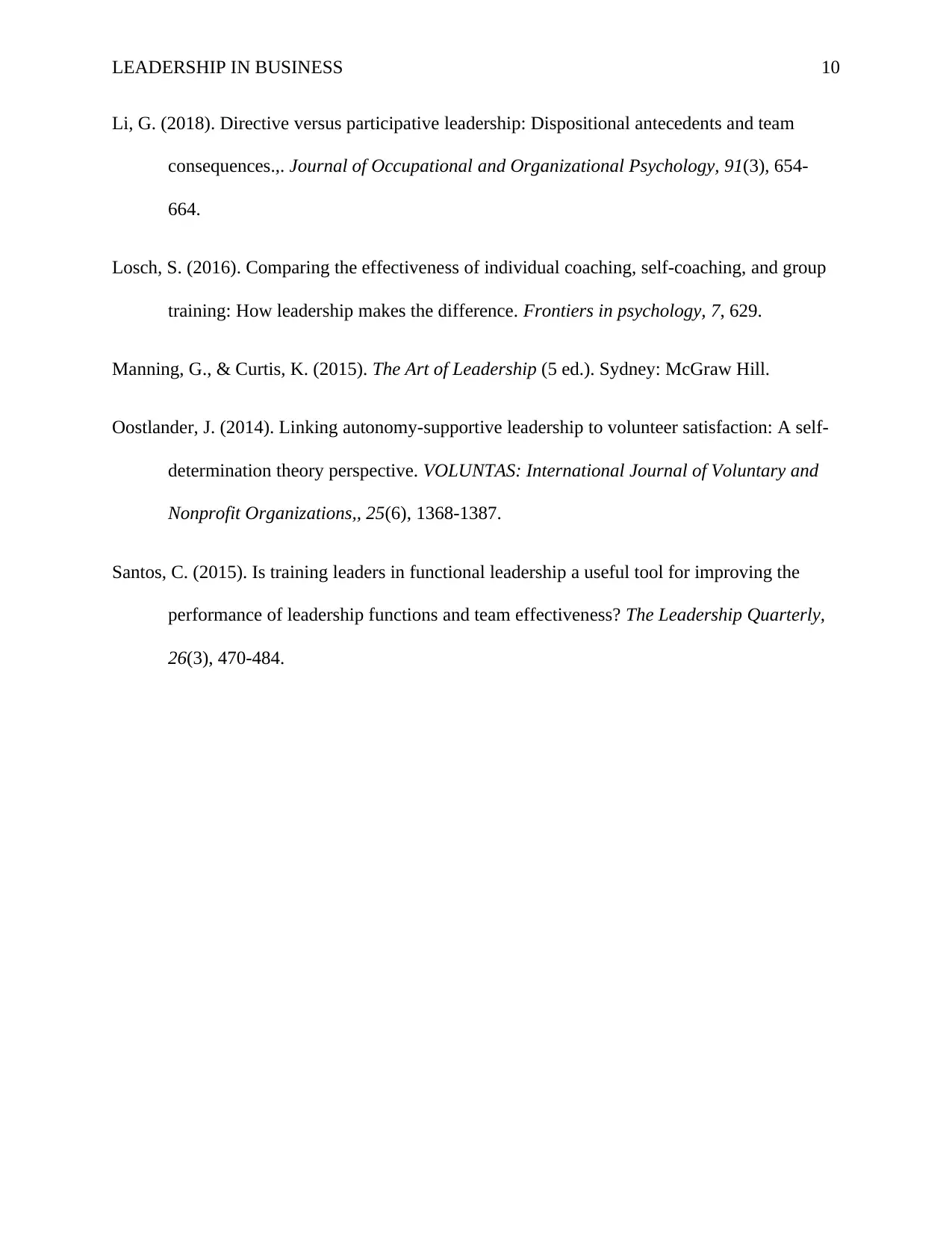
LEADERSHIP IN BUSINESS 10
Li, G. (2018). Directive versus participative leadership: Dispositional antecedents and team
consequences.,. Journal of Occupational and Organizational Psychology, 91(3), 654-
664.
Losch, S. (2016). Comparing the effectiveness of individual coaching, self-coaching, and group
training: How leadership makes the difference. Frontiers in psychology, 7, 629.
Manning, G., & Curtis, K. (2015). The Art of Leadership (5 ed.). Sydney: McGraw Hill.
Oostlander, J. (2014). Linking autonomy-supportive leadership to volunteer satisfaction: A self-
determination theory perspective. VOLUNTAS: International Journal of Voluntary and
Nonprofit Organizations,, 25(6), 1368-1387.
Santos, C. (2015). Is training leaders in functional leadership a useful tool for improving the
performance of leadership functions and team effectiveness? The Leadership Quarterly,
26(3), 470-484.
Li, G. (2018). Directive versus participative leadership: Dispositional antecedents and team
consequences.,. Journal of Occupational and Organizational Psychology, 91(3), 654-
664.
Losch, S. (2016). Comparing the effectiveness of individual coaching, self-coaching, and group
training: How leadership makes the difference. Frontiers in psychology, 7, 629.
Manning, G., & Curtis, K. (2015). The Art of Leadership (5 ed.). Sydney: McGraw Hill.
Oostlander, J. (2014). Linking autonomy-supportive leadership to volunteer satisfaction: A self-
determination theory perspective. VOLUNTAS: International Journal of Voluntary and
Nonprofit Organizations,, 25(6), 1368-1387.
Santos, C. (2015). Is training leaders in functional leadership a useful tool for improving the
performance of leadership functions and team effectiveness? The Leadership Quarterly,
26(3), 470-484.
1 out of 11
Related Documents
Your All-in-One AI-Powered Toolkit for Academic Success.
+13062052269
info@desklib.com
Available 24*7 on WhatsApp / Email
![[object Object]](/_next/static/media/star-bottom.7253800d.svg)
Unlock your academic potential
Copyright © 2020–2025 A2Z Services. All Rights Reserved. Developed and managed by ZUCOL.





